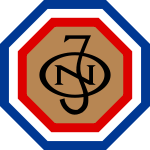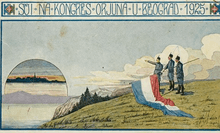Organization of Yugoslav Nationalists
The Organization of Yugoslav Nationalists (Organizacija Jugoslavenskih Nacionalista, ORJUNA; Организација Југославенских Националиста, ОРЈУНА), was a political organization in Yugoslavia that existed from 1921 to 1929. It supported Yugoslav nationalism, promoted the creation of a corporatist state, and attacked communism, democracy, Jews, separatists, Croatian nationalists, and Serbian nationalists.[1] Its leader was Milan Pribićević.[2] It is believed to have been influenced by fascism.[3] It was created in Split, in 1921, in order to fight communist insurgency and Croat separatism.[4]
Organization of Yugoslav Nationalists Organizacija Jugoslavenskih Nacionalista Организација Југославенских Националиста | |
|---|---|
 | |
| Historic Leader | Ljubo Leontić Niko Bartulović |
| Founded | 1921 |
| Dissolved | 1929 |
| Headquarters | Belgrade, Yugoslavia |
| Newspaper | ORJUNA |
| Youth wing | Mladi Jugoslavije |
| Paramilitary wing | Akcija Odjeljak |
| Ideology | Yugoslavism Nationalism Anti-communism Corporatism Antisemitism |
| Political position | Far right |
| Colors | Blue, White, Red (Yugoslav tricolour); Brown |
| |
History


ORJUNA was founded in March 1921 in Split by the royal administrator of Croatia and funded by the provincial government to secure Yugoslavia from threats posed by communists, separatists, and other persons deemed threatening to the state.[5] The first president was Marko Nani and the first secretary Edo Bulat. The first actions organized by JNNO were demonstrations against communists because of the communist assassination of the Minister of Interior Milorad Drašković. JNNO organized demonstrations in Split, Zagreb and Osijek. In Zagreb, JNNO members even demolished offices of newspapers that blamed the government for assassination.
It was particularly influential in areas of Slovenia and Croatia that were of interest to Italian and Austrian irredentism as well as in areas where ethnic minorities where viewed to be powerful or separatist, such as Hungarians in Vojvodina. The membership of the movement was ethnically mixed of the various Yugoslav nationalities. However most of its members were Croats from Dalmatia.[6] It ran its own newspapers, had an academic club, a labour organization, a high school students wing "Young Yugoslavia", and a paramilitary organization, the Action Section.[1]
After 1922 people of all age groups started to join the organization, which changed its name in May 1922 to ORJUNA. ORJUNA's main political goal was maintaining a unitary Yugoslav state. Its members clashed with Austrian and Italian border patrols.[1] ORJUNA never participated directly in elections but its supporters voted for Yugoslav oriented parties. In 1929, when the King proclaimed his personal dictatorship and disbanded the parliament, ORJUNA supported the King's action, but because the King outlawed all political parties and organizations ORJUNA ceased to exist.
By 1925, ORJUNA's Action Groups accounted for 10,000 people.[3]
Ideology
The primary ideological component of ORJUNA was Yugoslav nationalism. ORJUNA is believed to have been influenced by fascism in that like the original Italian Fascism had a similar organizational structure including a Yugoslav version of the Duce ("Leader"), titled Vođa and like Italian Fascism it glorified violence, including in its mottoes "Victory or Death" and "Whoever is not with us, is against us!".[3]
See also
Notes
- Blamires 2006, p. 745.
- Banac 1988, p. 187.
- Ramet 2006, p. 59.
- World Fascism: A Historical Encyclopedia, Volume 1 page 745
- Ramet 2006, pp. 58-59.
- Sugar 197, p. 137.
References
- Banac, Ivo (1988). The National Question in Yugoslavia: Origins, History, Politics. Ithica: Cornell University Press. ISBN 9780801494932.CS1 maint: ref=harv (link)
- Blamires, Cyprian P. (2006). World Fascism: A Historical Encyclopedia. Santa Barbara: ABC-CLIO. ISBN 978-1-57607-940-9.CS1 maint: ref=harv (link)
- Ramet, Sabrina P. (2006). The Three Yugoslavias: State-Building and Legitimation, 1918–2005. Bloomington: Indiana University Press. ISBN 978-0-253-34656-8.CS1 maint: ref=harv (link)
- Sugar, Peter F. (1971). Native Fascism in the Successor States, 1918-1945. Santa Barbara: ABC-CLIO. ISBN 9780874360745.CS1 maint: ref=harv (link)